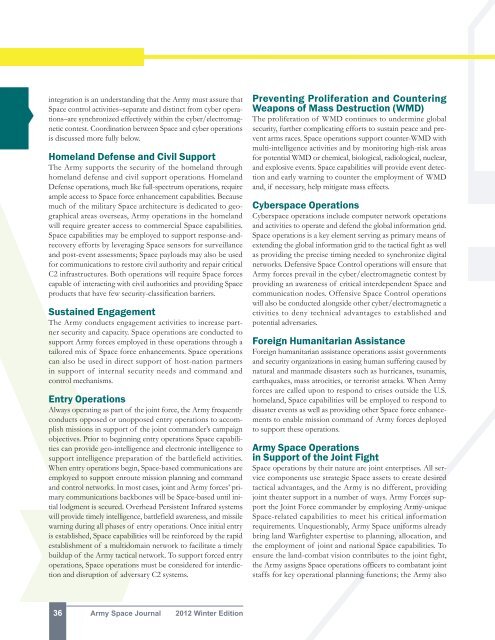2012 Winter - Space and Missile Defense Command - U.S. Army
2012 Winter - Space and Missile Defense Command - U.S. Army
2012 Winter - Space and Missile Defense Command - U.S. Army
You also want an ePaper? Increase the reach of your titles
YUMPU automatically turns print PDFs into web optimized ePapers that Google loves.
integration is an underst<strong>and</strong>ing that the <strong>Army</strong> must assure that<br />
<strong>Space</strong> control activities–separate <strong>and</strong> distinct from cyber operations–are<br />
synchronized effectively within the cyber/electromagnetic<br />
contest. Coordination between <strong>Space</strong> <strong>and</strong> cyber operations<br />
is discussed more fully below.<br />
Homel<strong>and</strong> <strong>Defense</strong> <strong>and</strong> Civil Support<br />
The <strong>Army</strong> supports the security of the homel<strong>and</strong> through<br />
homel<strong>and</strong> defense <strong>and</strong> civil support operations. Homel<strong>and</strong><br />
<strong>Defense</strong> operations, much like full-spectrum operations, require<br />
ample access to <strong>Space</strong> force enhancement capabilities. Because<br />
much of the military <strong>Space</strong> architecture is dedicated to geographical<br />
areas overseas, <strong>Army</strong> operations in the homel<strong>and</strong><br />
will require greater access to commercial <strong>Space</strong> capabilities.<br />
<strong>Space</strong> capabilities may be employed to support response-<strong>and</strong>recovery<br />
efforts by leveraging <strong>Space</strong> sensors for surveillance<br />
<strong>and</strong> post-event assessments; <strong>Space</strong> payloads may also be used<br />
for communications to restore civil authority <strong>and</strong> repair critical<br />
C2 infrastructures. Both operations will require <strong>Space</strong> forces<br />
capable of interacting with civil authorities <strong>and</strong> providing <strong>Space</strong><br />
products that have few security-classification barriers.<br />
Sustained Engagement<br />
The <strong>Army</strong> conducts engagement activities to increase partner<br />
security <strong>and</strong> capacity. <strong>Space</strong> operations are conducted to<br />
support <strong>Army</strong> forces employed in these operations through a<br />
tailored mix of <strong>Space</strong> force enhancements. <strong>Space</strong> operations<br />
can also be used in direct support of host-nation partners<br />
in support of internal security needs <strong>and</strong> comm<strong>and</strong> <strong>and</strong><br />
control mechanisms.<br />
Entry Operations<br />
Always operating as part of the joint force, the <strong>Army</strong> frequently<br />
conducts opposed or unopposed entry operations to accomplish<br />
missions in support of the joint comm<strong>and</strong>er’s campaign<br />
objectives. Prior to beginning entry operations <strong>Space</strong> capabilities<br />
can provide geo-intelligence <strong>and</strong> electronic intelligence to<br />
support intelligence preparation of the battlefield activities.<br />
When entry operations begin, <strong>Space</strong>-based communications are<br />
employed to support enroute mission planning <strong>and</strong> comm<strong>and</strong><br />
<strong>and</strong> control networks. In most cases, joint <strong>and</strong> <strong>Army</strong> forces’ primary<br />
communications backbones will be <strong>Space</strong>-based until initial<br />
lodgment is secured. Overhead Persistent Infrared systems<br />
will provide timely intelligence, battlefield awareness, <strong>and</strong> missile<br />
warning during all phases of entry operations. Once initial entry<br />
is established, <strong>Space</strong> capabilities will be reinforced by the rapid<br />
establishment of a multidomain network to facilitate a timely<br />
buildup of the <strong>Army</strong> tactical network. To support forced entry<br />
operations, <strong>Space</strong> operations must be considered for interdiction<br />
<strong>and</strong> disruption of adversary C2 systems.<br />
Preventing Proliferation <strong>and</strong> Countering<br />
Weapons of Mass Destruction (WMD)<br />
The proliferation of WMD continues to undermine global<br />
security, further complicating efforts to sustain peace <strong>and</strong> prevent<br />
arms races. <strong>Space</strong> operations support counter-WMD with<br />
multi-intelligence activities <strong>and</strong> by monitoring high-risk areas<br />
for potential WMD or chemical, biological, radiological, nuclear,<br />
<strong>and</strong> explosive events. <strong>Space</strong> capabilities will provide event detection<br />
<strong>and</strong> early warning to counter the employment of WMD<br />
<strong>and</strong>, if necessary, help mitigate mass effects.<br />
Cyberspace Operations<br />
Cyberspace operations include computer network operations<br />
<strong>and</strong> activities to operate <strong>and</strong> defend the global information grid.<br />
<strong>Space</strong> operations is a key element serving as primary means of<br />
extending the global information grid to the tactical fight as well<br />
as providing the precise timing needed to synchronize digital<br />
networks. Defensive <strong>Space</strong> Control operations will ensure that<br />
<strong>Army</strong> forces prevail in the cyber/electromagnetic contest by<br />
providing an awareness of critical interdependent <strong>Space</strong> <strong>and</strong><br />
communication nodes. Offensive <strong>Space</strong> Control operations<br />
will also be conducted alongside other cyber/electromagnetic a<br />
ctivities to deny technical advantages to established <strong>and</strong><br />
potential adversaries.<br />
Foreign Humanitarian Assistance<br />
Foreign humanitarian assistance operations assist governments<br />
<strong>and</strong> security organizations in easing human suffering caused by<br />
natural <strong>and</strong> manmade disasters such as hurricanes, tsunamis,<br />
earthquakes, mass atrocities, or terrorist attacks. When <strong>Army</strong><br />
forces are called upon to respond to crises outside the U.S.<br />
homel<strong>and</strong>, <strong>Space</strong> capabilities will be employed to respond to<br />
disaster events as well as providing other <strong>Space</strong> force enhancements<br />
to enable mission comm<strong>and</strong> of <strong>Army</strong> forces deployed<br />
to support these operations.<br />
<strong>Army</strong> <strong>Space</strong> Operations<br />
in Support of the Joint Fight<br />
<strong>Space</strong> operations by their nature are joint enterprises. All service<br />
components use strategic <strong>Space</strong> assets to create desired<br />
tactical advantages, <strong>and</strong> the <strong>Army</strong> is no different, providing<br />
joint theater support in a number of ways. <strong>Army</strong> Forces support<br />
the Joint Force comm<strong>and</strong>er by employing <strong>Army</strong>-unique<br />
<strong>Space</strong>-related capabilities to meet his critical information<br />
requirements. Unquestionably, <strong>Army</strong> <strong>Space</strong> uniforms already<br />
bring l<strong>and</strong> Warfighter expertise to planning, allocation, <strong>and</strong><br />
the employment of joint <strong>and</strong> national <strong>Space</strong> capabilities. To<br />
ensure the l<strong>and</strong>-combat vision contributes to the joint fight,<br />
the <strong>Army</strong> assigns <strong>Space</strong> operations officers to combatant joint<br />
staffs for key operational planning functions; the <strong>Army</strong> also<br />
36 <strong>Army</strong> <strong>Space</strong> Journal <strong>2012</strong> <strong>Winter</strong> Edition
















